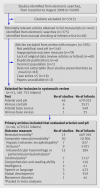Strength of association between umbilical cord pH and perinatal and long term outcomes: systematic review and meta-analysis
- PMID: 20466789
- PMCID: PMC2869402
- DOI: 10.1136/bmj.c1471
Strength of association between umbilical cord pH and perinatal and long term outcomes: systematic review and meta-analysis
Abstract
Objective: To evaluate the association between umbilical cord pH at birth and long term outcomes.
Design: Systematic review and meta-analysis.
Data sources: Medline (1966-August 2008), Embase (1980-August 2008), the Cochrane Library (2008 issue 8), and Medion, without language restrictions; reference lists of selected articles; and contact with authors.
Study selection: Studies in which cord pH at birth was compared with any neonatal or long term outcome. Cohort and case-control designs were included.
Results: 51 articles totalling 481 753 infants met the selection criteria. Studies varied in design, quality, outcome definition, and results. Meta-analysis carried out within predefined groups showed that low arterial cord pH was significantly associated with neonatal mortality (odds ratio 16.9, 95% confidence interval 9.7 to 29.5, I(2)=0%), hypoxic ischaemic encephalopathy (13.8, 6.6 to 28.9, I(2)=0%), intraventricular haemorrhage or periventricular leucomalacia (2.9, 2.1 to 4.1, I(2)=0%), and cerebral palsy (2.3, 1.3 to 4.2, I(2)=0%).
Conclusions: Low arterial cord pH showed strong, consistent, and temporal associations with clinically important neonatal outcomes that are biologically plausible. These data can be used to inform clinical management and justify the use of arterial cord pH as an important outcome measure alongside neonatal morbidity and mortality in obstetric trials.
Conflict of interest statement
Competing interests: All authors have completed the unified competing interest form at
Figures




Comment in
-
Umbilical cord blood gas analysis.BMJ. 2010 May 13;340:c1720. doi: 10.1136/bmj.c1720. BMJ. 2010. PMID: 20466790 No abstract available.
-
Umbilical cord pH and outcomes. Might measuring cord pH in itself affect outcome?BMJ. 2010 Aug 19;341:c4440. doi: 10.1136/bmj.c4440. BMJ. 2010. PMID: 20724406 No abstract available.
References
-
- Heller G, Schnell RR, Misselwitz B, Schmidt S. Umbilical blood pH, Apgar scores, and early neonatal mortality. Z Geburtshilfe Neonatol 2003;207:84-9. - PubMed
-
- Goodwin TM, Belai I, Hernandez P, Durand M, Paul RH. Asphyxial complications in the term newborn with severe umbilical acidemia. Am J Obstet Gynecol 1992;167:1506-12. - PubMed
-
- Williams KP, Singh A. The correlation of seizures in newborn infants with significant acidosis at birth with umbilical artery cord gas values. Obstet Gynecol 2002;100:557-60. - PubMed
-
- Kato EH, Yamada H, Matsumoto Y, Hattori S, Makinoda S, Fujimoto S. Relation between perinatal factors and outcome of very low birth weight infants. J Perinat Med 1996;24:677-86. - PubMed
Publication types
MeSH terms
Grants and funding
LinkOut - more resources
Full Text Sources
Medical
Miscellaneous
